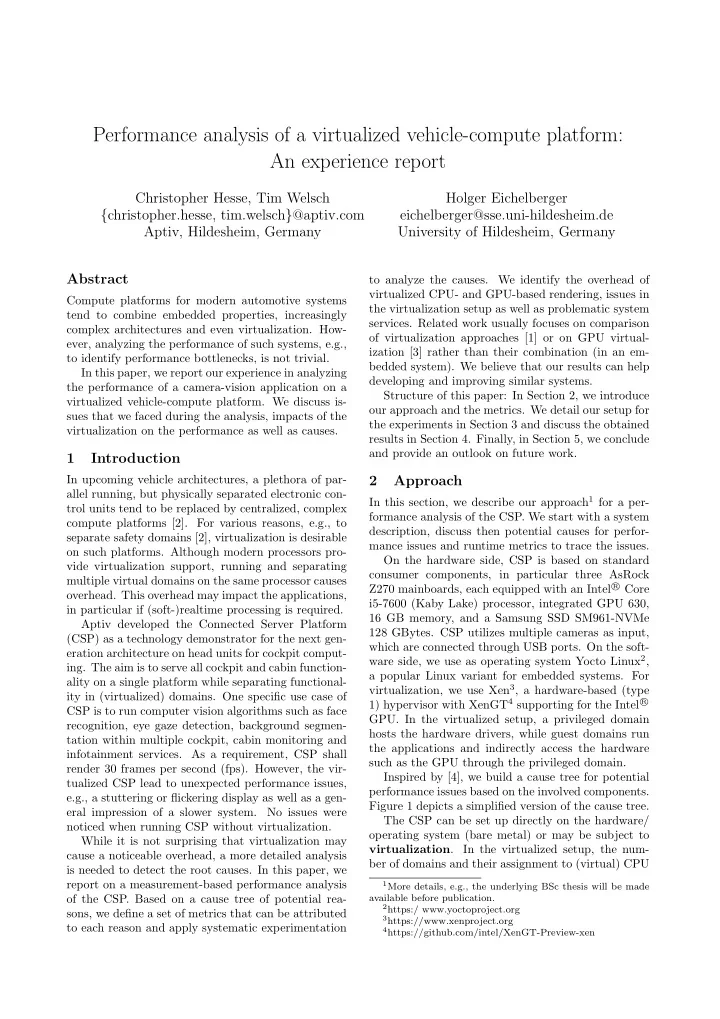

Performance analysis of a virtualized vehicle-compute platform: An experience report Christopher Hesse, Tim Welsch Holger Eichelberger { christopher.hesse, tim.welsch } @aptiv.com eichelberger@sse.uni-hildesheim.de Aptiv, Hildesheim, Germany University of Hildesheim, Germany Abstract to analyze the causes. We identify the overhead of virtualized CPU- and GPU-based rendering, issues in Compute platforms for modern automotive systems the virtualization setup as well as problematic system tend to combine embedded properties, increasingly services. Related work usually focuses on comparison complex architectures and even virtualization. How- of virtualization approaches [1] or on GPU virtual- ever, analyzing the performance of such systems, e.g., ization [3] rather than their combination (in an em- to identify performance bottlenecks, is not trivial. bedded system). We believe that our results can help In this paper, we report our experience in analyzing developing and improving similar systems. the performance of a camera-vision application on a Structure of this paper: In Section 2, we introduce virtualized vehicle-compute platform. We discuss is- our approach and the metrics. We detail our setup for sues that we faced during the analysis, impacts of the the experiments in Section 3 and discuss the obtained virtualization on the performance as well as causes. results in Section 4. Finally, in Section 5, we conclude and provide an outlook on future work. 1 Introduction In upcoming vehicle architectures, a plethora of par- 2 Approach allel running, but physically separated electronic con- In this section, we describe our approach 1 for a per- trol units tend to be replaced by centralized, complex formance analysis of the CSP. We start with a system compute platforms [2]. For various reasons, e.g., to description, discuss then potential causes for perfor- separate safety domains [2], virtualization is desirable mance issues and runtime metrics to trace the issues. on such platforms. Although modern processors pro- On the hardware side, CSP is based on standard vide virtualization support, running and separating consumer components, in particular three AsRock multiple virtual domains on the same processor causes � Core Z270 mainboards, each equipped with an Intel R overhead. This overhead may impact the applications, i5-7600 (Kaby Lake) processor, integrated GPU 630, in particular if (soft-)realtime processing is required. 16 GB memory, and a Samsung SSD SM961-NVMe Aptiv developed the Connected Server Platform 128 GBytes. CSP utilizes multiple cameras as input, (CSP) as a technology demonstrator for the next gen- which are connected through USB ports. On the soft- eration architecture on head units for cockpit comput- ware side, we use as operating system Yocto Linux 2 , ing. The aim is to serve all cockpit and cabin function- a popular Linux variant for embedded systems. For ality on a single platform while separating functional- virtualization, we use Xen 3 , a hardware-based (type ity in (virtualized) domains. One specific use case of 1) hypervisor with XenGT 4 supporting for the Intel R � CSP is to run computer vision algorithms such as face GPU. In the virtualized setup, a privileged domain recognition, eye gaze detection, background segmen- hosts the hardware drivers, while guest domains run tation within multiple cockpit, cabin monitoring and the applications and indirectly access the hardware infotainment services. As a requirement, CSP shall such as the GPU through the privileged domain. render 30 frames per second (fps). However, the vir- Inspired by [4], we build a cause tree for potential tualized CSP lead to unexpected performance issues, performance issues based on the involved components. e.g., a stuttering or flickering display as well as a gen- Figure 1 depicts a simplified version of the cause tree. eral impression of a slower system. No issues were The CSP can be set up directly on the hardware/ noticed when running CSP without virtualization. operating system (bare metal) or may be subject to While it is not surprising that virtualization may virtualization . In the virtualized setup, the num- cause a noticeable overhead, a more detailed analysis ber of domains and their assignment to (virtual) CPU is needed to detect the root causes. In this paper, we report on a measurement-based performance analysis 1 More details, e.g., the underlying BSc thesis will be made of the CSP. Based on a cause tree of potential rea- available before publication. 2 https:/ www.yoctoproject.org sons, we define a set of metrics that can be attributed 3 https://www.xenproject.org to each reason and apply systematic experimentation 4 https://github.com/intel/XenGT-Preview-xen
Recommend
More recommend